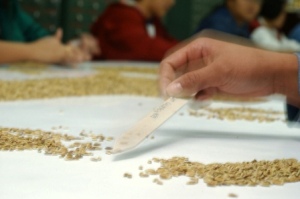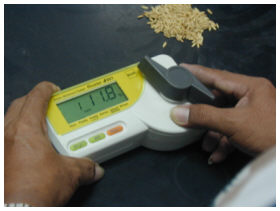Articles
Sample processing and viability in field banks (cultivated rice)
Contributors to this page: T.T. Chang Genetic Resources Centre-IRRI, Philippines (Ruaraidh Hamilton, Ken McNally, Flora de Guzman, Renato Reaño, Soccie Almazan, Adelaida Alcantara, Elizabeth Naredo); WARDA, Cotonou (Ines Sánchez); UPLB-University of the Philippines at Los Baños (Teresita Borromeo).
Provides guidelines and recommendations about the best practices for the daily management of genebanks, describing the most important procedures for sample processing and viability in field genebanks for cultivated rice. Best practices are shown in a pale blue color with bullets. Justification for each best practice is given within brackets (…).
Cleaning propagules/seeds in field banks
Source of planting materials in field banks
- Use seeds treated with additional care to assure germination and survival.
Visual inspection of plant materials
IRRI staff selecting good seeds for storage to the IRRI Genebank facility. (photo: IRRI)

- Check the materials carefully for pest or disease contamination.
- Consult the health diagnosis menu for specific details about pests and diseases.
Disposal of contaminated materials
To ensure plants do not spread by seeds or rhizomes, specific measures should be followed:
- Designate a disposal area (a pit about 3-4 meters deep from the surface ground) for burying discarded and burnt samples.
- Provide a modified incinerator or burning facility to accommodate burning activities especially during the rainy season.
- If sufficient seeds are obtained, old plants should be discarded, burned and buried into the pit.
- Excess planting materials (seeds, seedlings, rattooned tillers) should be collected, burned and buried after seeding, transplanting and/or replanting.
- All dried leaves/straws, unfilled grains, mixtures and off-types must be collected, burned and buried.
Seeds are germinated to check its viability and recorded.
Routine monitoring for field banks

(photo: IRRI)
Methods and frequency
- Survival rates - Check survival monthly (some germplasm that have to be maintained in a field genebank are perennial and regular monitoring is important to ensure survival).
- Vigor - Record vigor monthly.
- Pests and diseases - Inspect for pests and diseases monthly (this is sufficient to identify any pests or diseases and rescue the plants in case of problems).
- Replacement by other weeds - Rogue plants of other species regularly and at flowering time. Check taxonomy at least once in a year.
Recording information during sample processing and routine monitoring in field banks
The following information should be recorded for each step:
- Accession number (an ID number).

Using a moisture meter to check the moisture content of seeds. (photo: IRRI)
- Genus (genus name of the plant, entered in full).
- Species (species name of the plant, entered in full).
- Field bank site name (a code to indicate the site of seed production).
- Plot number (the plot number at the production site).
- Date of monitoring (date when data is collected).
- Name of staff (name of staff recording the data).
- Damage [a score of 1-5 (where 5 is damaged) on amount of damage (insect, disease etc)].
- Vigor [assessment of vigor of the plants on a scale of 1-5 (where 5 is high)].
- Details of plants removed or destroyed (due to type mixtures or pests or diseases contamination).
Comments
- No comments found




Leave your comments
Post comment as a guest